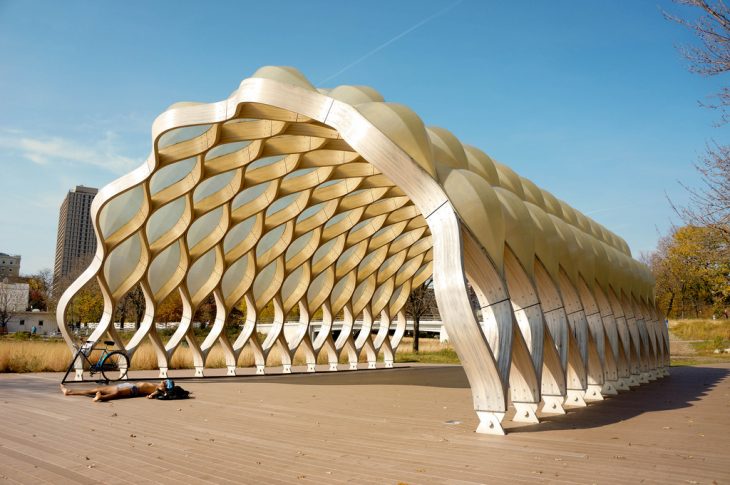PARAMETRIC PAVILION IN LINCOLN ZOO, CHICAGO :

The project transforms a picturesque urban pond from the 19th century into an ecological habitat buzzing with life. With the design’s improvements to water quality, hydrology, landscape, accessibility, and shelter, the site is able to function as an outdoor classroom in which the co-existence of natural and urban surroundings is demonstrated. A pavilion integrated into the boardwalk sequence provides shelter for open-air classrooms on the site. Inspired by the tortoise shell, its laminated structure consists of prefabricated, bent-wood members and a series of interconnected fiberglass pods that give global curvature to the surface.
Architect: Studio Gang Architects
Client: Lincoln Park Zoo
Project Area: 4 acres
Project Year: 2010
REFERENCE :
https://www.archdaily.com/83676/lincoln-park-zoo-south-pond-studio-gang-architects
PSEUDO CODE :
Geometry Creation ( Form Finding Process) :
1. Create an Arc.
2. Extrude the arc to create a surface of 10mm wide
3. Create a pattern on that surface using Interpolate curves.
4. Mirror the pattern to create 1 module.
5. Extrude these modules with a thickness.
6. Array the modules using Linear Array in Y direction upto 15 modules
7. Loft the two Interpolate curves (pattern) to get a surface.
8. Isotrim the surface to 10 parts in V direction and 1 part in U direction .
9. Evaluate each subsurface to get 5 points.
10. Create Catenary Arc using two points in each subsurface and multiply the length by 1.2 in Z direction.
11. Now Create a Bump in 10 sub surfaces using Network Surface Component.
Animation and Camera Movement :
12. Create animation for the initial arc using Subcurve.
13. Create animation for the pattern unrolling on the surface and also for the mirror one.
14. Create animation for the linear array of the patterns.
15. Create animations of the extrusion of the patterns.
16. Create animation of the curves forming a surface from the pattern and its placement in the pattern design.
17. Create animation of the above surface equal to the no of modules (patterns)
18. Create Camera Animation for the final design by setting the path of the camera.
19. Combine these 7 animations together to create a video.



Animated System Design
||Lincoln Zoo Pavilion is a project of IaaC, Institute for Advanced Architecture of Catalonia developed at the Master in Advanced Architecture in 2018 by:
Student: Manojraj Manachanallur Raju Periyasamy
Faculty: Rodrigo Aguirre, David Andres Leon
Assistant: Daniil Koshelyuk